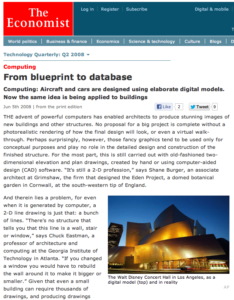Thank You The Economist. It’s great to see BIM in the business press.
In the positive spirit of the article, I’d like to share some of my thoughts on this editorial piece and raise some important questions about the adoption of BIM.
In the recent article in The Economist Technology Quarterly, the essential principles of BIM are identified and some good examples of projects using the technology are highlighted.
“Building Information Modelling (BIM) … Involves representing a building as a full, three-dimensional computer model (3D model), with an associated database”
After reading the article, I realised there were two important issues close to my heart that were not included. The first is the management of the BIM process and the second is the importance of the contractor in using BIM for virtual construction.
In recent times I’ve started to recognise that there is a potential risk to the successful adoption of BIM on projects if the BIM roles and responsibilities of the Architect, Engineers and Contractor are not clearly defined and if the BIM process is not effectively managed throughout the design and construction process.
“An immediate advantage of this approach is that the software can identify any mistakes within a design”
This is only true if all of the designers are engaged in the BIM process and the data structures, model naming conventions and analysis procedures for identifying clashes in the BIM model are defined and maintained. The software is not automated and like all applications, will only do what the users instruct.
It is technically possible. But who checks if a structural beam is in the same place as an air vent? Maybe it’s not the Architect’s problem. Can the beam be moved? Is the air vent in the exact location required and can it be relocated? Is the Contractor responsible for this co-ordination? Unless the specification for the BIM adresses these key issues, then the full potential of BIM will not be realised.
The article goes on to elude to how the designers can leverage the BIM models.
“Improve the communication and co-ordination between architects and engineers”
“Calculate the quantities of materials needed, and hence construction cost”
“Finite-element analysis can determine its structural properties”
“The building’s energy consumption, lighting, heat flow, acoustics and regulatory compliance” can all be determined.
And yes, that is all technically possible. BUT here’s the health warning. If these analyses are not planned at the outset it is mission impossible to retrofit them to a BIM digital prototype of a building.
So, should a specialised experienced BIM consultant be engaged to leverage this new and emerging technology on a building project? I believe, that BIM Managers and BIM Consultants have a key role to play in assisting clients, designers and contractors in gaining the maximum benefits from the BIM process.
And then, what about the people who know how to build these wonderfully complex buildings? This article suggests that only “a handful of pioneering architects” have used BIM.
This is somewhat mis-leading. The fastest adopters of this technology are the contractors. They know that detailed 3D CAD models can identify the design errors that “often become apparent only after construction has begun”. The builders are using BIM to find the design inconsistencies that “account for 2% of a typical construction budget and clashes for up to 5%”. And they’ve been doing it for years.
Beyond analysising the design documents they are able to link the 3D models to the planned construction programme to generate 4D Virtual Construction simulations. Some of our best clients know how to leverage this technology during the tender and planning stages of a project.
When the BIM models created by the designers are assembled in recognition of how the building will be erected, then even more value and savings can be accrued from the BIM process. Until the Architects and Engineers are instructed to issue their BIM models to the contractors, the true values of BIM will remain untapped. There are ways to over-come legitimate and also unfounded reasons as to why designers will not issue 3D files to the contractors.
Dr. Chuck Eastman, and many other champions of the benefits of BIM share my dream that BIM will be widely adopted in our industry. I look forward to that day when “there will be no drawings and ‘back to the drawing board’ will just become an historic phrase”
However, in order to live the dream, I believe that BIM consultants and the contractors have a pivotal role to play in the BIM process in collaboration with the Architects and Engineers.
Thank You Cian for sharing this article with me!
From blueprint to database Reference
The Economist
http://www.economist.com/science/tq/displaystory.cfm?story_id=11482536






